The tank on my 550 looks clean from the outside but it had a lot of crusty rust inside. I’ve used muriatic acid to clean tanks before but I wanted to try another method. So, I talked to my buddy Ryan who is a material scientist of sorts for a living and he gave me the run down of how to do electrolysis to remove rust.
Supplies:
salt
metal
water
electrical tape
DC power
Tape the petcock shut.
Dilute roughly 2 cups of salt in water and pour it in the tank and continue filling the tank until it’s almost full.
Connect the positive to the tank and the negative to the metal bar and cook it between 6 AMPs and 8 AMPs for 30 to 45 minutes. If it’s too low in AMP’s add more salt and if it’s too much dilute the mixture.
This process worked great for removing the chunky rust so I suggest doing this and then a quick acid wash to finish the job.
11 responses to “Electrolysis Tank Cleaning”
Leave a Reply
You must be logged in to post a comment.

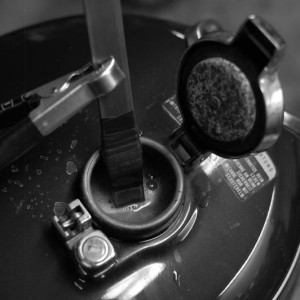
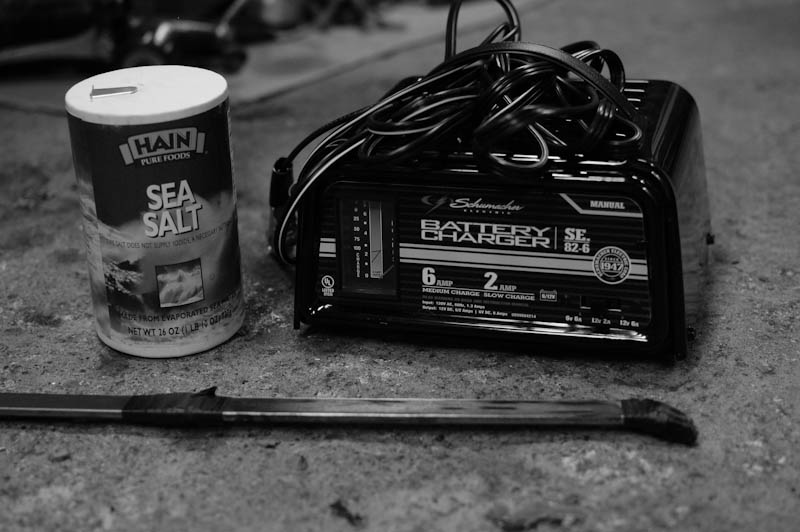
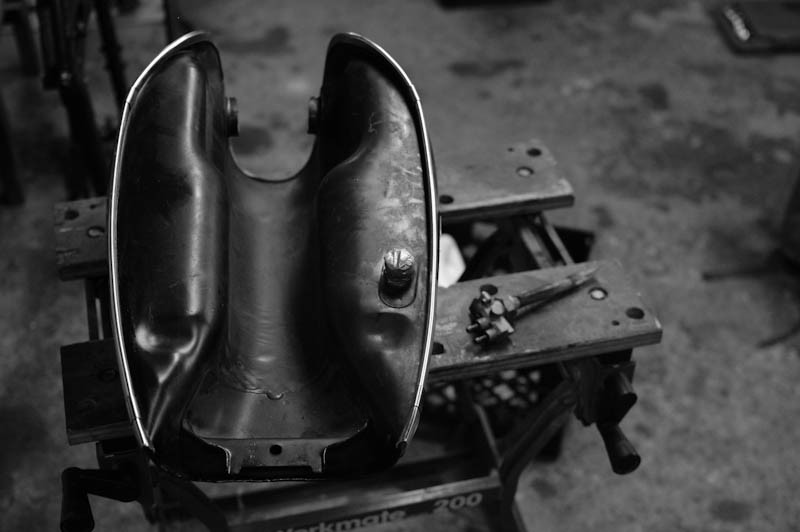
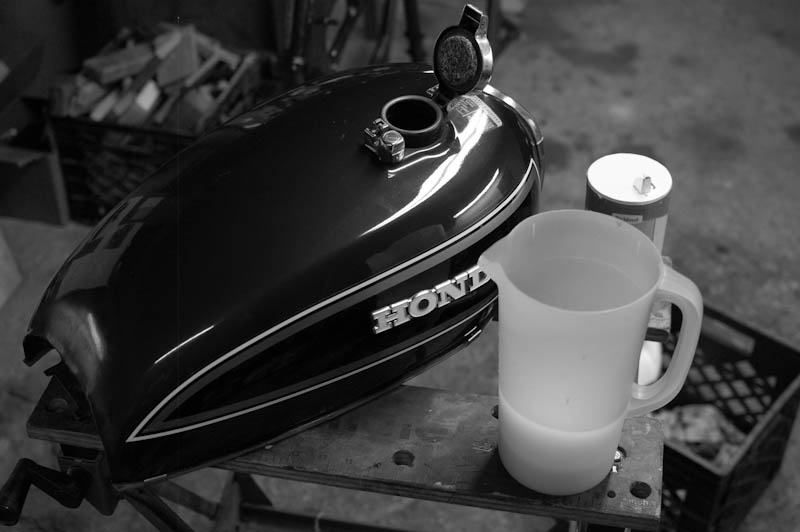
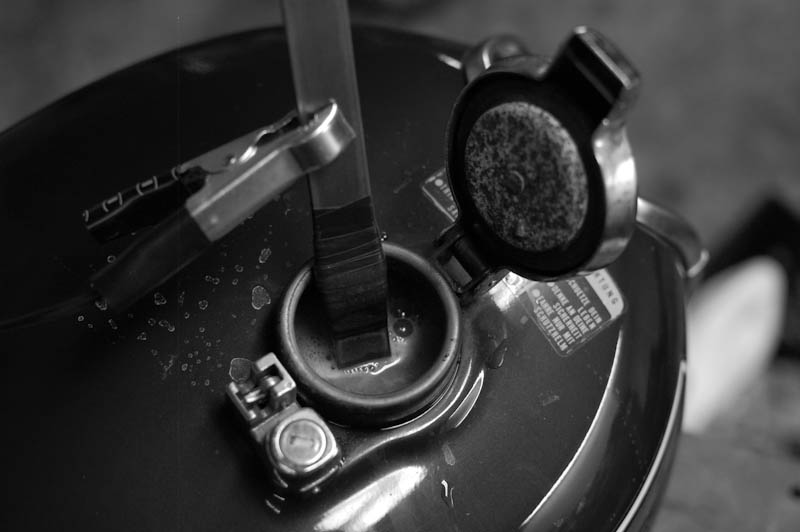
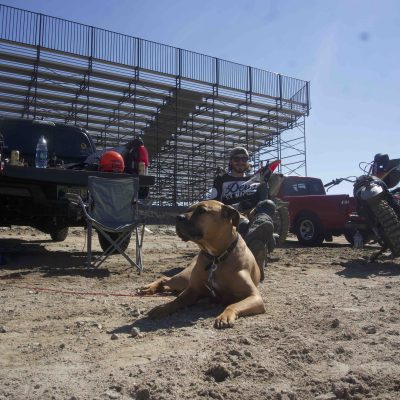
Looks like a fun science project. Does that battery charger have an ammeter on it or did you connect one in-line to determine your amperage?
where on the tank does the positive attach to? anywhere?
positive to the metal rod… negative to the tank. Great trick!
The battery charger had an ampmeter on it.
I scraped a little bit of paint off of the tank lip that fits into the rubber mount just infront of the seat and attached the positive there.
The positive should be attached to the tank and the negative to the rod because electricity flows from positive to negative and I would think that’d be the logical way you would want the current flowing…
Did you seal the tank after the acid wash? If so, what did you use? Any flash rust problems?
I have a 1973 Honda CB350 that is going to get this treatment in the spring. I used a similar method to remove rust from some parts last year, but I used washing soda (sodium carbonate) instead of salt. For the DC power source, a battery charger works well.
Instead of muriatic acid, I plan to use phosphoric acid to wash out the tank. Phosphoric acid will react with any remaining rust in the tank to form iron phosphate, which forms a neutral, passive layer that protects the underlying metal from further rust.
Oh, and don’t let the iron rod/bar touch the tank itself. it has to sit in the liquid but not touch the metal, otherwise the current will simply flow through the metal of the tank itself between the negative and positive connections. The current has to flow between the tank and the bar through the electrolyte (liquid). The bar will get a covering of rust in the process.
An advantage of using washing soda instead of salt is that yuou can dump the solution in the garden when you are done, it won’t harm anything.
One more caution.. this process works for the inside of gas tanks, and ordinary iron or steel parts in a solution bath. it does not work well for stainless steel. And DO NOT use it for chromed parts, unless you like handling carcinogenic chromates in the used solution (which are classed as toxic, hazardous waste).
I second all that Patrick says.. you can buy sodium bicarbonate at Safeway, with laundry soap, Arm & Hammer brand. I just did this recently to my cb350 tank and it works well. I found it did remove large chunks, but still was a mess inside, after a solid week of electrolyxising, so I tried a second, two-part, non toxic method.
I filled the thing with old nuts, bolts and washers and maybe 1/2 gal of water, and shook for 15 min. It’s heavy and I’m a girl and it sucked, but then I filled it with 3 gallons of regular white vinegar and let it sit for four days. I drained, strained, and saved the vinegar. I shook it with water and nuts and bolts again for 15 minutes (maybe really only 10) and rinsed it a bunch, and then refilled with the filtered vinegar and let it sit for another three or four days.
By the weekend I drained it out and was pretty thrilled to find it damn clean. Still some rusty spots, but it was like 93% shiny. I did rinse it with water from the garden hose a bunch and then sat the tank on my apartment’s heater for a few days to thoroughly dry out.
It was a free tank, so was kind of an experiment. Also note, I removed the paint on the outside, so can’t speak for what the vinegar will do to paint. It created some light streaks on the bare steel. I used enough aircraft stripper on that job to destroy my carbon footprint for a while.. thought I’d try organic on the inside.
I expected some flash rust, but it seems to be okay. I expected the outside to rust quickly too, but sprayed it with Gibbs and rubbed down. I may end up needing to treat the inside, but am focusing on jetting issues and the rest of this bike’s rebuild for now.
Just wanted to say that using ordinary table salt is an rely BAD idea.
When you use it it frees CHLORINE GAS which was used in ware fare during WW1.
Also graphite is better than steel because dirt don’t stick to it so it is less of a hassle. Buy on ebay dirt cheap.
a good link to what is needed to know is:
http://www.metaldetectingworld.com/electrolysis_rust_removal.shtml
Btw. you take very nice photos! 🙂
The POSITIVE lead goes on the metal strip(anode) and the NEGATIVE lead on the tank (cathode). Research it.